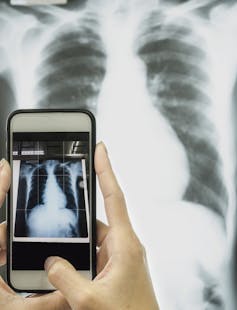Doctors already use phones to share clinical images of patients - legislation needs to catch up
- Written by Adrian Dyer, Associate Professor, RMIT University
Imagine this scenario: you’re a recently graduated doctor working at a medical clinic in rural Australia. A person presents with a bite of what seems to be a poisonous spider - but you’re not sure. You take a photo of the skin lesion on your phone, and post it in a social media group to source swift advice from more experienced experts.
Digital image capturing devices like smartphones have enormous potential to facilitate communication for time critical medical interventions. And, as a society, we all seem to be part of a contract where we tacitly consent to immediate, mass distribution of images depicting us.
But there’s a catch: image capture and storage may fail to comply with current legislative frameworks for privacy, with significant ethical, legal and security implications.
As a society, it’s time for us to review how digital imaging is changing healthcare, security and other specialities.
Read more: Artificial intelligence won’t replace a doctor any time soon, but it can help with diagnosis
Legal use of information
Australian legislation refers to the 1988 Privacy Act framework for guidelines about the legal and ethical use of information, including images.
This legislation was developed during a time of centralised practice of medical photography – when images were physically stored at a hospital, and could not be reproduced, or accessed, without due authorisation.
But all this changed with the advent of smartphone-enabled cameras that can capture, process and mass distribute an image instantly.
Legislative changes to the Australian Privacy Act took effect in March 2014 following the introduction of the Privacy Amendment Act 2012 and the Privacy Regulation 2013.
Under these changes, people or medical professionals with unsecured patient images on their smart devices could face fines up to A$340,000, and institutions up to A$1,700,000 for breaches of patient privacy.
At a national level, mandatory data breach notification obligations will come into force in early 2018.
Read more: Sorry everyone: on the internet, you’re always the product
But it’s not clear how this federal legislation interacts with state regulation of digital images. Individual state governments apply a range of acts to meet specific requirements in some sectors.
For example, those that apply in the medical sector in Victoria include the Freedom of Information Act, Guardianship and Administration Act, Medical Treatment Act, Health Records Act, Charter of Human Rights and Responsibilities Act and the Mental Health Act.
Different states and territories have different acts, and this is problematic. Digital images can be sent instantly across state or national borders and easily redistributed through social media. So which laws should apply?
How photos aid medical practice
Medical photographs can be an essential part of patient treatment. They allow medical staff to document the treatment of illness, to communicate among medical professionals and to teach.
 A phone capture of your health image may be shared without your consent.
www.shutterstock.com
A phone capture of your health image may be shared without your consent.
www.shutterstock.com
Surveys of image usage in Australian hospitals suggest that medical professionals frequently capture and store patient data on smartphones, sharing them between colleagues.
Although legislation requires signed informed consent for the storage and use of images, this appears often not to be collected, especially if a patient is not in a state to be able to grant consent. This means there is a large disconnect between image usage, and legislative requirements.
Medical professionals including doctors and nurses have probably been the most progressive in enabling surveys of current professional practices. This serves as a high value source of information for considering how changes in technology and work practice may need to be reflected in consistent legislation, independent of state borders.
Also a problem in policing
Collection and application of digital imagery in policing similarly presents new legal and ethical challenges.
In Australia, various states are either trialling or using body cameras, and police may be permitted to use personal capture devices.
But guidelines for when images of a potential crime should be captured are different between Australian states. Concerns over when evidence should be collected, and who has access to such evidence have only started to be considered in Australia.
 Body Worn Cameras were rolled out by the Queensland Police Service in 2016.
Queensland Police/AAP
Body Worn Cameras were rolled out by the Queensland Police Service in 2016.
Queensland Police/AAP
Towards solutions
We recently discussed issues relating to legal and ethical use of digital images at the 2016 Australian Ethics Network conference.
The field of ethics management aims to ensure that data is collected, stored and distributed in a way that is consistent with moral principles, and legislative framework within a given jurisdiction. The use of digital images that can be instantly transferred across state and national borders presents many challenges.
We need sector and region specific information to answer these questions. What are the benefits to a medical professional of having instant image access, how should this be balanced with personal consent if a life is in danger? How should use of images for policing be balanced with privacy if image distribution may result in the prevention of crime?
Possible technology solutions could include developing apps that securely store and manage data by restricting access to authorised persons. Such a process will require coordination between policymakers and professional sectors, and a conversation with the public on how we can best use digital images in an ethical way, not only for medicine but across research disciplines.
Authors: Adrian Dyer, Associate Professor, RMIT University





